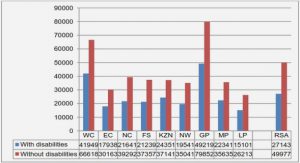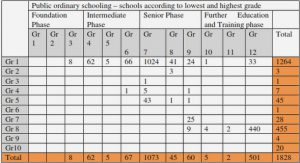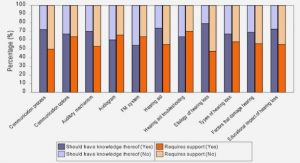Get Complete Project Material File(s) Now! »
Spherical collapse and Press-Schechter theory
The evolution of these perturbations is however not fully described in the linear regime, as perturbations later enter a non-linear regime when particle orbits start to cross and invalidate the one-flow approximation. In particular, density peaks later collapse into virialised haloes and galaxies. This collapse is well described by the spherical collapse model which consists in solving the Friedmann equation for an over dense sphere of radius r in a flat universe. This successfully de-scribes the competition between the global expansion of the universe that tends to spread particles apart, and the gravitational potential that tend to collapse them into one point.
This allows to calculate the turnover radius rmax = 6ri 10δi, which is the maximum radius the sphere reaches before it begins to shrink as gravity takes over and the density contrast above which a sphere will collapse to a point δcol = 1 686 (for Λ = 0. ΩΛ = 0 7 leads to δcol = 1 676). In reality, the over density is not smooth but rather composed of particles which do not accumulate in one point but shell-cross and reach virial equilibrium. In this case, the same model predicts that the ratio between the density inside the sphere at virial equilibrium and the average background density at time of collapse will be: ρ(tvirial) = 18π2 ≃ 178 (11).
assuming that Λ = 0. Interestingly, this provides a well justified criterium to discriminate collapsed structures in simulations. Fully developed galaxies will later form at the center of virialised dark haloes from the accumulation of cold dense gas streaming to the core of the haloes and form-ing stars. Note that a non-zero cosmological constant, this ratio is actually redshift dependent (Bryan & Norman, 1998).
Another neglected aspect of the collapse stems from the non-sphericity of density peaks and will be developed in Chapter 1. Noticeably haloes and pro to-galaxies acquire angular momentum through misalignments between their tensor of inertia (ellipticity) and the eigenvectors of the tidal tensor that describes gravitational tidal interactions on large scales. This ability of galaxies to acquire rotation can have a major impact on their subsequent morphology.
Following on this analysis, it is therefore of interest to derive the statistics of collapsed struc-tures, especially the fraction of haloes of a given mass M at a given time. In order to understand when and with which rate over-dense clouds smoothed on a typical scale R (hence enclosing a typical mass M ∼ 4πR3 3) will collapse, Press & Schechter (1974) investigated the evolution of such smoothed gaussian random fields describing the smoothed density contrast δ. The mass of such a cloud smoothed on scale R is : Z M (r) = ρ(x)W (x + r R )d3x.
Adaptive mesh refinement
RAMSES is an adaptive mesh refinement code, which means that the grid is not uniform but rather refines or de-refines automatically (i.e. splits one cell into 8 sub-cells) in dense regions from one time step to the next so as to naturally adapt to the local density and successfully follow the dynamics of the gas and particles in the highly non-linear regions. In HORIZON-AGN , the initial mesh is refined up to Δx = 1 kpc (7 levels of refinement). This is done according to a quasi-Lagragian criterion: if the number of DM particles in a cell is more than 8, or if the total baryonic mass in a cell is 8 times the initial DM mass resolution, a new refinement level is triggered. In order to keep the minimum cell size approximately constant in physical units, a new maximum level of refinement is allowed every time the expansion scale factor doubles (i.e. at aexp = 0 1, 0 2, 0 4 and 0 8).
Small-scale physical recipes for realistic galactic dynamics.
Once the dynamics is computed for the gas and the particles, simulating a physical universe still requires to compute the non-linear physics that govern small scales of the Universe. Since our resolution is limited to 1 kpc, many of these processes actually occur on typical scales smaller than the smallest cell in the simulation. They are consecutively labeled as « sub-grid processes », hence only modeled through their effective impact on cell scales. Let us review all such processes implemented in HORIZON-AGN .
Gas cooling and heating
Photons interact with electrons -either bound in an atom or free- in many ways that can impact the overall energy of the system. Specifically, photons can excite bound electrons to either higher energy bound states which will soon after decay radiating away the excess energy, or to unbound states which may lead to the subsequent recombination of the electron with another photon (ioniza-tion/recombination). Free electrons can also transfer their kinetic energy to background photons through two channels: bremsstrahlung (fly-by braking) or inverse Compton scattering (head-on collision). These processes, each of which dominates in a specific temperature range, therefore re-duce the internal energy of the gas. This loss of energy e˙ therefore depends on the number density of protons np and electrons ne: e˙ ∝ nenp (1.13).
In the temperature range 104 − −105 K, gas is at ionization equilibrium, leading to a plasma where the number density of electrons and the proton number density are related through specific coefficients that account for the rates of spontaneous emission, absorption and stimulated emission respectively. The loss of energy writes e˙ = fcool(T )npne where fcool(T ) is a cooling rate that encapsulates the efficiency of each process at a given temperature T.
In HORIZON-AGN , gas is allowed to cool by H and He cooling with a contribution from metals assuming a solar composition by implementing the cooling rate from the Sutherland & Dopita (1993) model down to 104 K. This leads to add the cooling term C in the energy equation of the Euler system. Metallicity is modelled as a passive variable for the gas and its amount is modified by the injection of gas ejecta during supernovae explosions and stellar winds. Various chemical elements synthesised in stars are released by stellar winds and supernovae: O, Fe, C, N, Mg and Si. However, it is important to remind that they do not contribute separately to the cooling curve (the ratio between each element is taken to be solar for simplicity) but can be used to probe the distribution of the various metal elements Quasars and hot massive stars are also thought to produce an intense UV radiation able to heat the gas from very high redshift (Haehnelt et al. , 2001; Dunkley et al. , 2009). In order to model this effect, heating from a uniform UV background is triggered in HORIZON-AGN after redshift zreion = 10 following the frequency-integrated ionization and photo-heating rates computed from the spectra of quasars in Haardt & Madau (1996). This adds the heating term H in the energy equation of the Euler system. .
Star formation and stellar feedback
Stars form from the collapse of giant molecular clouds or ultra-dense infrared dark clouds (under Jeans instability) emerging from the cooling of high-density gas. This suggests that the star formation rate must be a function of the local gas density, a relationship that reveals surprisingly tight in observations (Kennicutt (1998)) which found it to be close to ρ ˙ ∝ ρ3/2 . This behavior star gas can be understood as the result of the star formation rate following a Schmidt law: ρ˙star = ǫ∗ρt ff (1.14).
where ρ˙star is the star formation rate density, ǫ∗ = 0 02 (Kennicutt, 1998; Krumholz & Tan, 2007) the constant star formation efficiency, and tff the local free-fall time of the gas: tff = 3π (1.15). However, observations also reveal that stars form only in regions where the gas density exceeds a given threshold that corresponds to the transition from atomic hydrogen to molecular hydro-gen(Kennicutt, 1998; Wong & Blitz, 2002). Following on this behavior, although with some cor-rections to overcome the limited resolution of the simulation, star formation in HORIZON-AGN is allowed in regions which exceed a gas Hydrogen number density threshold of n0 = 0 1 H cm−3. In such regions, at each time step, a small fraction of gas is converted into star particles the density of which is given by the Schmidt law, and whose individual masses are multiple of the minimum mass M∗ = ρ0Δx3 ≃ 2 × 106 M⊙. The multiple is drawn from a Poissonian random process (Rasera & Teyssier, 2006; Dubois & Teyssier, 2008).
The gas pressure is artificially enhanced above ρ > ρ0 assuming a polytropic equation of state T = T0(ρρ 0)κ−1 with polytropic index κ = 4 3 to avoid excessive gas fragmentation and mimic the effect of stellar heating on the mean temperature of the interstellar medium (Springel & Hernquist, 2003).
Haloes and galaxies: Structure identification and merging
identification Haloes and galaxies are identified from DM particles and star particles respectively using HaloMaker (Tweed et al. , 2009, based on) with the AdaptaHOP algorithm (Aubert et al. , 2004). This subsection only summarizes the main features of the algorithm.
This method identifies structures from the particle positions only, no further correction is per-formed based on the velocities. Its great advantage is however its ability to detect sub-structures. It first computes the density at each particle position by finding its N nearest neighbors and integrating their contribution to the local density using the standard SPH (smoothed particle hy-drodynamics) spline kernel (Monaghan (1992). A total of 20 neighbours were used to compute the local density of each particle in our post-processing of HORIZON-AGN .
Then the algorithm hops from one particle to its highest density neighbor until it reaches a local maximum. Once all the local maxima of the field are found, a peak patch around each maximum is defined as the set of particles above a well-suited density threshold (ρ ρ¯ > ρth where ρ¯ is the average of the total matter density) that share this local maximum. In the following work, I chose ρth = 178 to identify clear collapsed, virialised structures: haloes and galaxies. At this point, detected overdensities still need to be discriminated into main structures and sub-structures of various levels.
It is performed first identifying the saddle points between interfacing patches. The connecting saddle point between two patches is identified as the particle of highest density among all their saddle points. Those saddle points are used to create branches connecting all the local maxima in a group of adjacent patches with saddle point densities higher than ρthρ¯. It allows to build a hierarchy of nodes, where each node contains all the particles in the group whose associated density is enclosed between two values. For a connex group of interfacing patches, the lowest level (0) node is constituted of all the particles in the group with associated density higher than the threshold ρthρ¯ and lower than the lowest saddle point detected (if any). Particles with density above this value are splitted into two level 1 nodes depending on their proximity to the two local maxima associated to this saddle point. This operation is repeated iteratively over all saddle points in the group in ascending order of their density: Particles in level 1 nodes are splitted into higher level nodes if their density is higher than that of the lowest of the remaining saddle points adjacent to the patch of the maximum they have been temporarily assigned to.
Physical structures correspond to the highest level -« leaf- » nodes, which are nodes that cannot be further splitted. Structures and sub-structures of various hierarchical levels are then recovered collapsing this node structure tree along the branch containing the most massive leaf node (« MSM » technic). This defines the main structure. This operation is then repeated with the most massive remaining leaf node, whose branch is collapsed down to the the lowest level node not assigned yet, and then again until all leaf nodes are assigned a substructure hierarchical level. A force softening (minimum size below which substructures are considered irrelevant) of ∼ 2 kpc is applied to discard small fluctuations or clumps as substructures.
Moreover, only structures with a minimum number of particles (fixed as an input parameter to 50, 100 or 1000 in this work) are identified as haloes or galaxies. The center of a structure is then identified as the particle of highest density, its inertia tensor is computed from the positions of its particles, which allows to infer its axis ratios when assuming its shape to be ellipsoidal. Mass is then computed in concentric ellipsoids with axis (ai b i c i) and same axis ratios until the enclosed particles verify the condition: ||2Ek + Ep || < 0 2 (1.16).
Table of contents :
Introduction
0.1 Structure formation in the early universe: linear perturbation theory
0.2 Spherical collapse and Press-Schechter theory
0.3 The cosmic web
0.4 Galactic morphologies
0.5 Structure of this Thesis
1 Numerical Methods
1.1 Simulating the universe on cosmological scales
1.1.1 RAMSES: basic features
1.1.2 Small-scale physical recipes for realistic galactic dynamics.
1.2 Structure detection and identification in Horizon-AGN
1.2.1 Haloes and galaxies: Structure identification and merging
1.2.2 Synthetic galaxies in Horizon-AGN
1.2.3 The numerical cosmic web
2 Galactic spin alignments induced by the cosmic web
2.1 Orientation of dark haloes in the cosmic web
2.1.1 The spin of dark haloes: a mass segregated distribution
2.1.2 Tidal Torque Theory
2.1.3 A dynamical scenario
2.1.4 Mergers versus smooth accretion
2.1.5 From haloes to galaxies
2.2 Tracing galactic spin swings in the cosmic web
2.2.1 Numerical Methods
2.2.2 Evolution tracers
2.2.3 Alignments in Horizon-AGN
2.2.4 Comparison to observations
2.3 How mergers drive spin swings in the cosmic web
2.3.1 Tracking mergers in Horizon-AGN
2.3.2 Mergers, stellar mass and spin in Horizon-AGN: close-up case studies
2.3.3 Mergers and smooth accretion on spin orientation
2.3.4 Mergers and smooth accretion on acquisition of spin.
2.4 Conclusion
3 Orientation of satellites galaxies: massive hosts versus the cosmic web
3.1 An overview of satellite galaxies
3.1.1 The formation of satellite galaxies in CDM cosmology
3.1.2 The distribution of satellite galaxies
3.2 Satellites in Horizon-AGN
3.2.1 Identifying central galaxies and satellites
3.2.2 Tracing the evolution of satellites in the halo: synthetic colors.
3.3 Statistical properties of the orientation of satellites
3.3.1 Methods and variables
3.3.2 Results
3.4 A dynamical scenario : satellites migrating into the halo.
3.4.1 Scenario
3.4.2 Corotation of satellites
3.4.3 Evolution of satellites within the halo
3.5 Implications for observations.
3.5.1 Color selection
3.5.2 Signal on smaller scales
3.5.3 Effects of the shape of the central host and high-z alignments.
3.6 Conclusion.
4 The rise and fall of stellar disks at z > 1
4.1 Inflows and galaxy encounters: an overview
4.1.1 Disc galaxies: evolution of the Hubble sequence with redshift
4.1.2 Violent Disc Instability: the path to compact spheroids
4.1.3 Mergers
4.1.4 Dry or wet mergers? Extended spheroids and massive disks.
4.2 Characterizing different types of mergers in Horizon-AGN
4.2.1 Characterizing the morphology of galaxies
4.2.2 Gas content of high-z galaxies
4.2.3 Merger rates: from observations to simulation
4.3 Size growth of galaxies
4.3.1 Galactic stellar density
4.3.2 Galactic half-mass radius
4.3.3 Impact of initial gas fraction and morphology
4.4 Impact on morphologies
4.4.1 Smooth accretion
4.4.2 Mergers
4.5 Conclusion
4.6 Main results
4.7 Prospects
4.7.1 Sorting out the merger zoo
4.7.2 Gas inflows: feeding galaxies into diverse morphologies ?
4.7.3 Distribution of satellites
Bibliography




